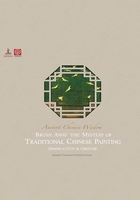
五牛图 (wǔ niú tú)
Five Oxen
A painting featuring five oxen on flax paper created nearly 1,300 years ago has been widely recognized as the earliest extant paper painting in China and is also known today as one of the top 10 masterpieces in the country’s art history.
This painting, a handscroll measuring 20.8 by 139.8 cm, ink and color, has long been attributed to Han Huang (723-787 AD), an official of the Tang Dynasty (618-907 AD) who once served as a chancellor under the reign of Emperor Dezong (742-805 AD).
Han Huang’s “Five Oxen” is the earliest extant paper painting in China. Today it is considered one of China’s great artistic masterpieces. In the painting, Han lined up five oxen horizontally with no background except some brambles on the right. The animals are vividly and elegantly rendered in different postures and angles.

Artist: Han Huang (723-787 AD)
Year: Tang Dynasty (618-907 AD)
Type: Ink and color on paper
Dimensions: 20.8 × 139.8 cm
Location: Palace Museum, Beijing
During his long career in the officialdom, Han served in a number of offices, such as imperial censor, defense, rites, civil service affairs, executive bureau of government as well as the prefect and governor in various parts of the country. He had also participated in a number of campaigns to suppress rebellions against the imperial court.
However, besides his political success and personal integrity, today people remember him more as a great artist and calligrapher, especially as the creator of the painting entitled “Five Oxen.”
In painting, Han was originally a follower of several great Chinese painters including Gu Kaizhi (circa 345-406 AD), widely deemed as the father of classical Chinese figure painting. And in calligraphy, he learned from ingenious calligraphers such as Zhang Xu (circa 675-750 AD), known as the Sage of Cursive Script.
Later, Han himself became distinguished at painting figures and agricultural life, including livestock such as oxen, goats and donkeys.
Most ancient Chinese paintings are about flowers, birds, figures and landscapes, so Han’s painting of “Five Oxen” is an exception. Some say that it could manifest China’s agriculture-oriented culture since the painter was once an imperial court chancellor in charge of agriculture.
In the painting, Han lined up the five oxen horizontally with no background. But the five animals are vividly rendered in different postures. For instance, the first one on the left is looking forward, the second looking back, the fourth looking upward and the fifth grazing.
The third ox, the fulcrum of the painting, is painted full-frontal, demonstrating the artist’s superb modeling skill.
In the painting, the painter employed the traditional Chinese ink-line drawing technique to delineate the powerful skeleton structure and muscles of the oxen in a fairly accurate anatomical perspective.

➊
According to historical records, Han painted a number of well-known paintings, but only “Five Oxen” has survived today. Aside from pastoral themes, Han was also said to be an excellent figure painter. In Han’s time, most Chinese artists only focused on images of noble families or mythical figures, and thus Han’s pastoral paintings were noteworthy.
The lines are sure and smooth, drawn with great deliberation. Particularly, the eyes of the oxen are so meticulously painted that they bring the animals to life.
The colors applied in the painting are light and elegant, with beautiful shades and gradation to bring into full display of such animal’s pulchritude.
The painter didn’t mark the painting with his name or seal, but later more than a dozen celebrities had added colophons either on the painting itself or on its borders and endpapers.
Among them is Zhao Mengfu (1254-1322), one of the greatest painters and calligraphers in China’s history.
Zhao, in his comment on the painting, praised it as a “rare gem” in the art world and categorically attributed it to the Tang Dynasty painter Han Huang.
According to historical records, Han had painted a number of well-known paintings, but only “Five Oxen” has survived today.
The painting changed hands many times during its long history of transmission. In 1900, during the Eight-Nation Alliance’s invasion and occupation of Beijing, then capital of the Qing Dynasty (1644-1911), the precious painting disappeared.
It was not until early 1950s that words were passed to late Chinese Premier Zhou Enlai by a patriot in Hong Kong that the painting would go under the hammer there soon.
Zhou immediately instructed cultural officials to send people to Hong Kong to verify the authenticity of the rare painting and retrieve it at all costs.

“Fighting Bulls” by Dai Song, a follower of Han Huang
When the painting finally arrived in Beijing, it was found to be in shabby condition due to improper storage. Among other imperfections, the painting was dotted with several hundred tiny moth holes.
In 1977, the Palace Museum in Beijing, where the painting is stored now, organized a team of experts to restore the painting to its present form. However, the masterpiece has rarely been put on public display since that time to protect it from further damage.